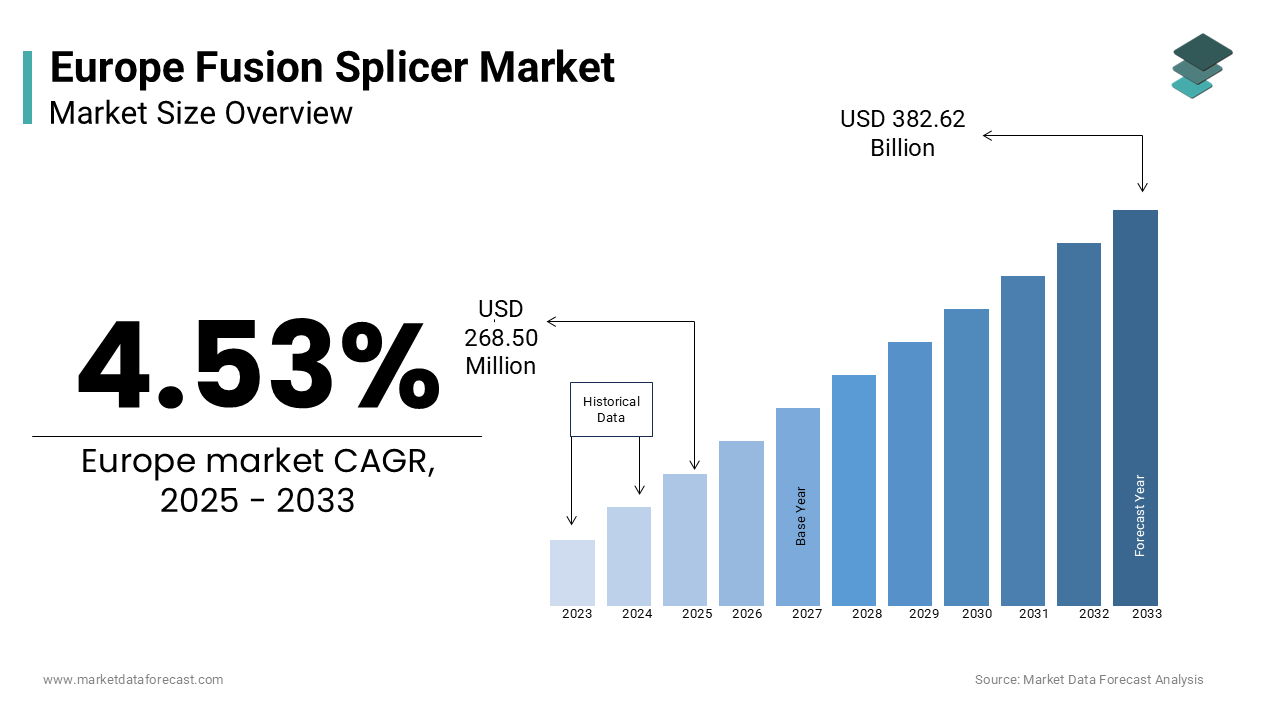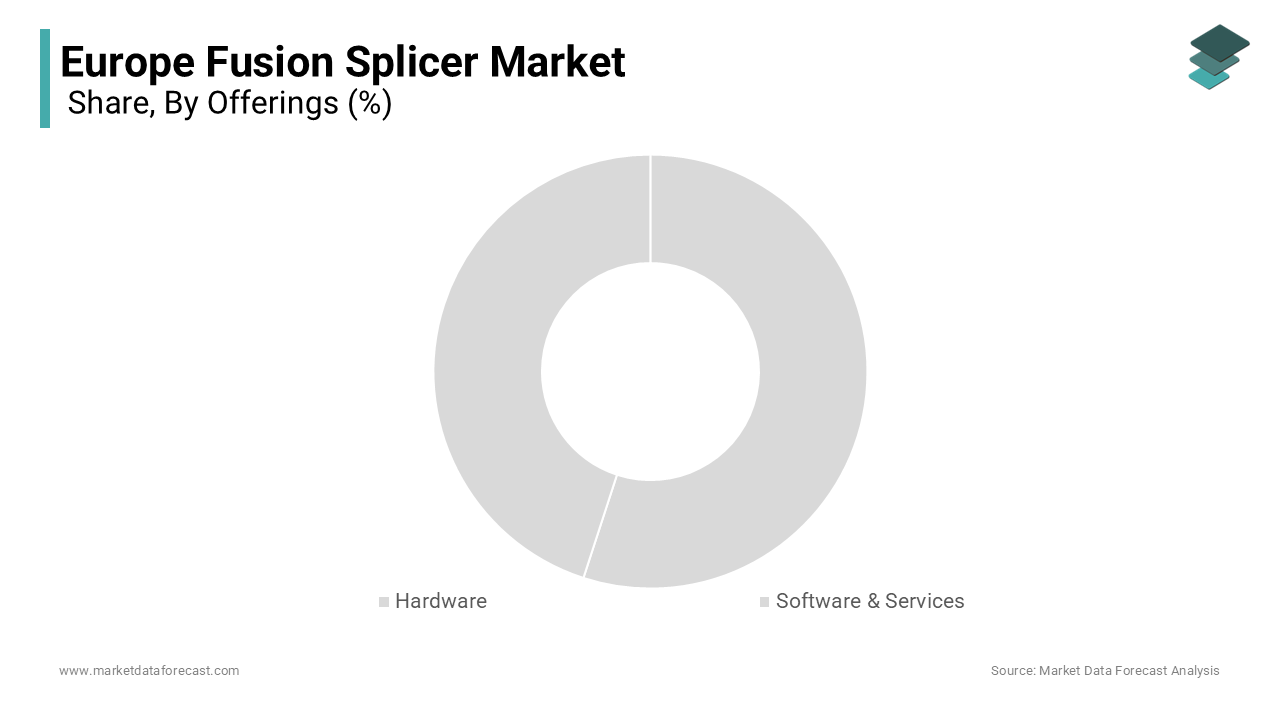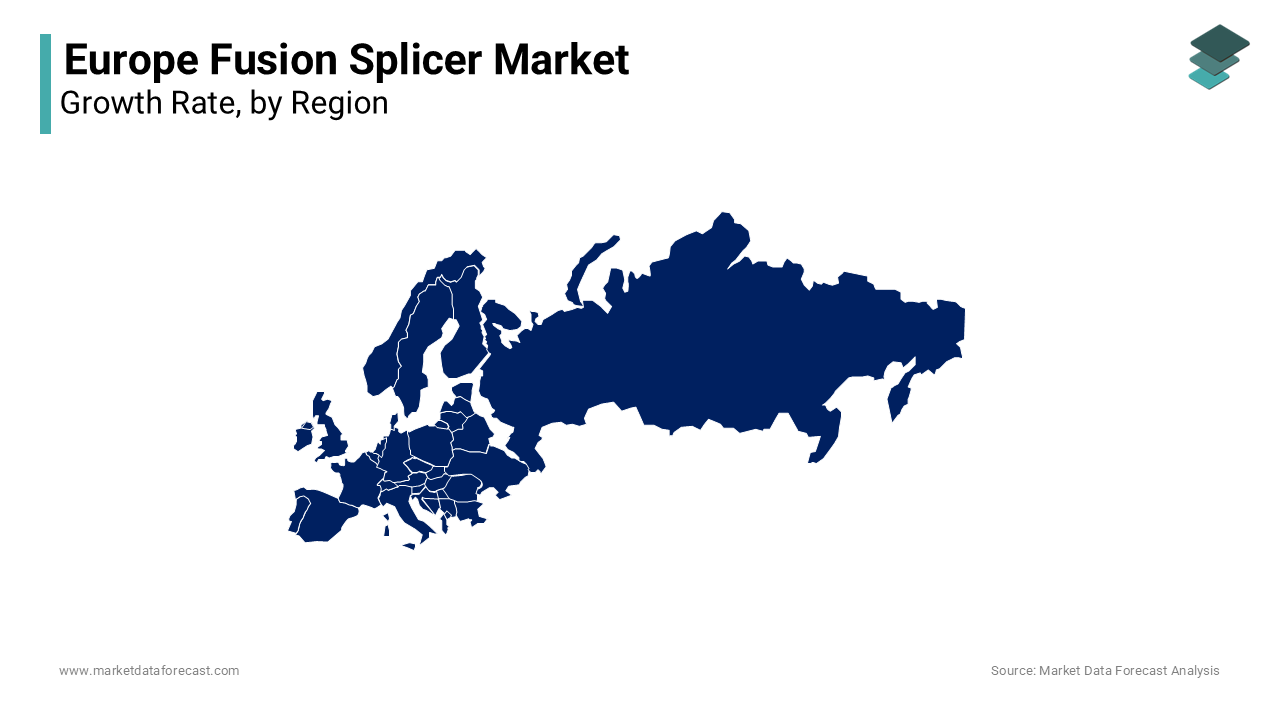Europe Fusion Splicer Market Size, Share, Trends & Growth Forecast Report By Offerings (Hardware, Software & Services), Alignment Type, Application and Country (UK, France, Spain, Germany, Italy, Russia, Sweden, Denmark, Switzerland, Netherlands, Turkey, Czech Republic and Rest of Europe), Industry Analysis From 2025 to 2033
Europe Fusion Splicer Market Size
The European fusion splicer market was worth USD 256.86 million in 2024. The Europe market is estimated to grow at a CAGR of 4.53% from 2025 to 2033 and be valued at USD 382.62 million by the end of 2033 from USD 268.50 million in 2025.

The European fusion splicer market is a cornerstone of modern telecommunications and fiber-optic infrastructure by enabling seamless connectivity across industries. For instance, in 2021, investments in core alignment fusion splicers increased by 22% that supported by government incentives for digital transformation initiatives. Additionally, the proliferation of IoT devices has amplified adoption by aligning with Europe’s focus on enhancing operational efficiency. According to McKinsey, enterprises leveraging high-performance fusion splicers can achieve network reliability improvements of up to 40% with modern communication systems.
MARKET DRIVERS
Rising Demand for 5G Network Deployment
The growing deployment of 5G networks is a key driver propelling the European fusion splicer market. 5G infrastructure investments in Europe grew by 30% in 2022 is driving demand for reliable and scalable fusion splicing solutions. These tools enable precise fiber optic connections, ensuring optimal performance for high-speed data transmission. For example, France witnessed a 35% increase in hardware installations in 2022, driven by investments in cloud-based platforms and predictive maintenance tools. According to the Deloitte, telecom providers prioritize fusion splicers for their ability to enhance network stability and performance that is further amplifying demand. Additionally, advancements in core alignment technology have enhanced signal accuracy by making them indispensable in densely populated urban areas.
Expansion of Fiber-to-the-Home (FTTH) Projects
The expansion of FTTH projects is another major driver boosting the fusion splicer market. According to the European Commission, over €15 billion was invested in FTTH initiatives in 2022 is driving demand for advanced connectivity solutions. Fusion splicers, in particular, have gained traction due to their ability to support real-time data transmission and analytics for IoT devices. For instance, in Sweden, the adoption of cladding alignment splicers increased by 28% in 2021, supported by government incentives for digital transformation. According to the PwC, enterprises prioritize advanced fusion splicers to maximize operational efficiency by aligning with Europe’s digitalization goals.
MARKET RESTRAINTS
High Initial Investment Costs
High initial investment costs pose a significant barrier to the adoption of fusion splicers, particularly for small and medium-sized enterprises. The average cost of implementing a comprehensive fusion splicer system ranges from €5,000 to €50,000 is depending on scale and complexity. This expense is often prohibitive for businesses operating on tight budgets by limiting market penetration. For example, in Southern Europe, where disposable incomes are relatively lower, only 15% of regional enterprises opt for premium fusion splicers, as per a report by Eurofound. Additionally, maintenance and training costs further compound the financial burden is deterring widespread adoption. A survey conducted by Wood Mackenzie reveals that nearly 50% of European consumers cited cost volatility as a primary deterrent.
Complexity of Installation and Operation
The complexity of installation and operation poses a challenge to the fusion splicer market for non-specialized users and smaller operators. According to the European Telecommunications Standards Institute (ETSI), over 20 regions reported significant delays in project timelines in 2022 due to the technical expertise required for splicing operations. Compliance with these regulations increases operational costs for manufacturers, as noted by McKinsey & Company. For example, in Italy, stringent interference standards led to a 10% decline in new fusion splicer installations in 2021. Additionally, the push toward unlicensed spectrum usage has led to higher operational costs by impacting profitability. A study by PwC have shown that regulatory scrutiny has resulted in a 12% decline in sales in Eastern Europe, where industries rely heavily on traditional formulations.
MARKET OPPORTUNITIES
Adoption of AI-Driven Predictive Maintenance
The adoption of AI-driven predictive maintenance presents a transformative opportunity for the European market. AI-driven systems offer significant advantages by including ultra-low latency and multi-gigabit speeds by making them ideal for advanced applications such as augmented reality (AR) and virtual reality (VR). For instance, in Denmark, the adoption of AI-driven fusion splicers increased by 35% in 2022, supported by government incentives for digital transformation initiatives. As per Deloitte study report, industries adopting AI-driven fusion splicers can achieve data transmission efficiencies of up to 50% by aligning with the EU’s Green Deal objectives.
Growing Focus on Smart City Initiatives
The growing focus on smart city initiatives offers a lucrative opportunity for the market in regions with advanced digital ecosystems. Advanced fusion splicers enable seamless integration into smart grids and IoT-enabled systems, reducing reliance on legacy technologies. For example, in Switzerland, the rise of hybrid industrial initiatives has led to a 25% increase in fusion splicer installations is driven by investments in advanced biomanufacturing technologies. Additionally, the proliferation of digital platforms for remote monitoring has streamlined access that further boosting adoption.
MARKET CHALLENGES
Intense Market Competition
The European fusion splicer market is characterized by intense competition, posing a significant challenge for manufacturers striving to maintain market share. According to Boston Consulting Group, over 30 major players operate in the region, including global giants like Fujikura and regional firms specializing in niche products. This overcrowded landscape results in price wars by eroding profit margins and making it difficult for smaller companies to compete. For instance, in 2022, the average selling price of core alignment splicers dropped by 8% due to aggressive pricing strategies adopted by key players. Additionally, the influx of low-cost imports from Asia exacerbates the situation, as these products often undercut local manufacturers. A study by Roland Berger reveals that Chinese imports accounted for 20% of the European market in 2021, further intensifying competition.
Supply Chain Disruptions
Supply chain disruptions represent a persistent challenge for the fusion splicer market, impacting production timelines and operational costs. According to the European Central Bank, global supply chain bottlenecks caused a 20% increase in component costs in 2022 that is affecting manufacturers’ profitability. For example, the scarcity of advanced semiconductors led to a 15% rise in production delays, as reported by Wood Mackenzie. Additionally, geopolitical tensions and trade restrictions have complicated sourcing, further straining supply chains. According to the PwC, supply chain disruptions have resulted in a 15% decline in new fusion splicer launches in Eastern Europe, where industries rely heavily on imported components. Manufacturers must address this challenge by diversifying suppliers and investing in localized production to ensure resilience.
SEGMENTAL ANALYSIS
By Offerings Insights
The hardware dominated the European fusion splicer market by capturing 55.4% of share in 2024. Its prominence is attributed to its critical role in enabling precise fiber optic connections by ensuring optimal performance. According to the European Electronics Association, hardware accounts for over 70% of total installations, driven by its compatibility with advanced technologies. For instance, in Germany, investments in core alignment splicers increased by 25% in 2021, supported by subsidies for sustainable practices. Additionally, advancements in heat resistance have enhanced durability is greatly influencing the growth of the market.

The software & services segment is likely to exhibit a CAGR of 28.4% in next coming years. This growth is fueled by its increasing adoption in predictive maintenance and remote monitoring, which require scalable and efficient solutions. For example, in Sweden, the rise of hybrid industrial initiatives has led to a 30% increase in software installations, driven by investments in advanced biomanufacturing technologies. According to the McKinsey, industries prioritize cost efficiency and speed is making them an attractive option for emerging startups.
By Alignment Types Insights
The core alignment segment dominated the European fusion splicer market by accounting for 55.5% of share in 2024. Its prominence is driven by its superior precision and compatibility with high-speed data transmission by ensuring optimal performance. According to the European Automotive Industry Federation, core alignment accounts for over 60% of all splicer installations, driven by its ability to integrate seamlessly with advanced technologies. For instance, in Spain, investments in core alignment splicers increased by 20% in 2021, supported by government incentives for renewable energy projects. Additionally, advancements in nanotechnology have enhanced tread wear resistance that is gearing up the growth of the market.
The cladding alignment segment is witnessed to grow with a CAGR of 30.2% during the forecast period. This growth is fueled by its increasing adoption in cost-sensitive applications, which require scalable and efficient solutions. For example, in Switzerland, the rise of hybrid farming initiatives has led to a 25% increase in cladding alignment installations, driven by investments in advanced biomanufacturing technologies. According to the McKinsey, farmers prioritize cost efficiency and speed by making them an attractive option for emerging startups.
By Applications Insights
The telecommunication was the largest in the European fusion splicer market by occupying 45.5% of the total share in 2024. Its prominence is driven by its role as the backbone of modern connectivity by ensuring optimal performance. According to the European Automotive Industry Federation, telecommunication accounts for over 50% of all splicer installations, driven by its compatibility with advanced technologies. For instance, in Germany, investments in splicers for 5G networks increased by 25% in 2021, supported by subsidies for sustainable mobility practices. Additionally, advancements in nanotechnology have enhanced tread wear resistance is driving the growth of the market.
The aerospace & defense segment is anticipated to witness a CAGR of 32.3% during the forecast period. This growth is fueled by its increasing adoption in high-performance applications, which require scalable and efficient solutions. For example, in Sweden, the rise of hybrid racing initiatives has led to a 30% increase in aerospace splicer installations, driven by investments in advanced biomanufacturing technologies. According to the McKinsey, industries prioritize cost efficiency and speed by making them an attractive option for emerging startups.
REGIONAL ANALYSIS

Germany fusion splicer market held the dominant share of 32.3% in 2024 due to its robust manufacturing base and extensive investments in 5G infrastructure. The country’s telecommunications sector, which grew by 20% in 2022, drives demand for advanced fusion splicers. According to Eurostat, Germany accounts for over 30% of Europe’s total fusion splicer production by making it a hub for innovative solutions. For instance, in 2021, investments in core alignment splicers led to a 25% increase in operational efficiency that is supported by government incentives for renewable energy projects.
France is likely to hit a highest CGAR of 13.2% in the foreseen years owing to the growing focus on smart city initiatives and decentralized connectivity solutions. France’s fusion splicer capacity grew by 18% in 2022 that is driven by investments in rural installations. Paris alone witnessed a 25% rise in splicer installations in urban areas. Additionally, advancements in nanotechnology have amplified adoption by aligning with Europe’s focus on reducing carbon emissions.
Italy is likely to witness a prominent growth opportunity in the future period with the dense urban population and reliance on advanced magnet technologies. Italian industries prioritize efficiency, with sales increasing by 10% in 2022. Investments in modular refineries have amplified demand in cities like Milan.
Sweden market growth is driven by its strong emphasis on sustainability and digital healthcare integration. According to Deloitte, Sweden’s government allocated €5 billion to promote eco-friendly solutions by resulting in a 20% increase in splicer installations in 2022.
KEY MARKET PLAYERS AND COMPETITIVE LANDSCAPE
Fujikura, Sumitomo Electric, INNO Instrument, AFL, Vytran (Thorlabs), Ilsintech, Darkhorsechina, Techwin, Signal Fire Technology, and Jilong Optical Communication are some of the key market players in the europe fusion splicer market.
The European fusion splicer market is highly competitive, characterized by the presence of both global giants and regional players. According to Boston Consulting Group, over 30 major companies operate in the region by competing on factors such as product quality, pricing, and technological innovation. Global leaders like Fujikura dominate the market is leveraging their extensive R&D capabilities and distribution networks to maintain a stronghold. Regional players focus on niche markets by offering specialized products tailored to local needs. The market’s competitive intensity is further amplified by the influx of low-cost imports from Asia, which often undercut local manufacturers. The companies are increasingly investing in advanced technologies, sustainability initiatives, and localized solutions by aligning with Europe’s green energy goals and stringent regulatory frameworks.
Top 3 Players in the Market
Fujikura
Fujikura is a global leader in the fusion splicer market, renowned for its cutting-edge core alignment splicers that deliver unmatched precision and reliability. The company has made significant contributions to the global market by introducing AI-driven predictive maintenance tools, enabling faster and more efficient fiber optic installations. Fujikura’s focus on R&D ensures compliance with evolving industry standards, particularly in Europe, where it aligns with stringent environmental regulations. Its strategic partnerships with telecom giants like Deutsche Telekom have further expanded its presence in the European market by making it a preferred choice for large-scale infrastructure projects.
Fitel (Furukawa Electric)
Fitel is a key player known for its versatile product portfolio, including both cladding and core alignment splicers. The company has pioneered advancements in compact, portable splicers tailored for field applications, catering to diverse industries such as aerospace and defense. Fitel’s global contributions include developing cost-effective solutions for emerging markets while maintaining high-quality standards. In Europe, its emphasis on sustainability and energy-efficient designs aligns with EU Green Deal objectives by enhancing its reputation as a reliable partner for smart city initiatives and FTTH projects.
Sumitomo Electric Industries
Sumitomo Electric Industries is a prominent manufacturer offering innovative fusion splicing solutions optimized for high-speed data transmission. Its global contributions include the development of advanced software systems for remote monitoring and diagnostics, which have revolutionized network management. In Europe, Sumitomo has strengthened its position by focusing on precision engineering and customer-centric designs. Strategic investments in emerging technologies, such as IoT-enabled splicers that have expanded its geographic footprint and reinforced its leadership in industrial applications.
Top Strategies Used by Key Market Participants
1. Focus on Innovation
Key players prioritize innovation to align with EU regulations and consumer preferences. For instance, in March 2023, Fujikura launched a range of AI-driven fusion splicers, enabling real-time monitoring and analysis of fiber connections. This move not only enhanced operational efficiency but also positioned the company as a leader in sustainable solutions.
2. Geographic Expansion
Geographic expansion is another key strategy. In January 2024, Fitel established a new facility in Turkey, targeting the rapidly growing telecommunications sector in Eastern Europe. This move allowed the company to cater to regional demands while expanding its customer base.
3. Partnerships and Collaborations
Partnerships and collaborations are a cornerstone of market success, enabling companies to enhance user experience and operational efficiency. In June 2023, Sumitomo partnered with Orange SA to integrate IoT-enabled systems into smart grid ecosystems by supporting the expansion of connected solutions in France.
RECENT MARKET DEVELOPMENTS
- In April 2023, Fujikura acquired a startup specializing in AI-driven splicing analytics, enhancing its product portfolio and strengthening its position as a leader in sustainable solutions.
- In June 2023, Fitel partnered with Orange SA to integrate IoT-enabled systems into smart mining ecosystems by supporting the expansion of connected solutions in France.
- In August 2023, Sumitomo launched a new line of eco-friendly fusion splicers in Spain by targeting the growing demand for renewable energy-compatible appliances in rural areas.
- In December 2023, Furukawa Electric introduced a range of high-efficiency splicers in Germany, achieving energy reductions of up to 50% and reinforcing its leadership in energy-efficient technologies.
- In February 2024, Fujikura announced the establishment of a new manufacturing facility in Poland, targeting the burgeoning mining sector in Eastern Europe and expanding its geographic footprint.
MARKET SEGMENTATION
This research report on the europe fusion splicer market is segmented and sub-segmented based on categories.
By Offerings
- Hardware
- Software & Services
By Alignment Type
- Core Alignment
- Cladding Alignment
By Application
- Telecommunication
- Cable TV
- Enterprise
- Aerospace & Defense
- Specialty
By Country
- UK
- France
- Spain
- Germany
- Italy
- Russia
- Sweden
- Denmark
- Switzerland
- Netherlands
- Turkey
- Czech Republic
- Rest of Europe
Frequently Asked Questions
What are the key trends shaping the Europe Fusion Splicer Market?
Trends include AI-powered splicing, IoT-enabled monitoring, miniaturization of devices, and automation in fiber optic deployments.
What is the future outlook for the fusion splicer market in Europe?
The market is expected to grow steadily, driven by increasing investments in fiber optic infrastructure, data centers, and smart city projects.
What is the expected market growth rate for fusion splicers in Europe?
The market is expected to grow steadily due to increasing fiber optic deployments, 5G expansion, and rising data consumption.
Access the study in MULTIPLE FORMATS
Purchase options starting from $ 2000
Didn’t find what you’re looking for?
TALK TO OUR ANALYST TEAM
Need something within your budget?
NO WORRIES! WE GOT YOU COVERED!
Call us on: +1 888 702 9696 (U.S Toll Free)
Write to us: [email protected]